My first experience with the Canon EOS R1 was in the sweltering heat of Phoenix, Arizona with a pre-production unit. There is of course, only so much that you can test with a pre-production unit under predefined conditions.
Fast forward to the present day and the winter weather isn’t the only thing different this time around. We got our hands on a ready-for-retail Canon EOS R1 unit and decided to test it at a Calgary Canucks junior league hockey game, which is not only a very Canadian pursuit but is also a sport that the Canon autofocus is not specifically trained for.
There is no denying that the $6,300 price limits who this camera is suited for but flagship cameras always come at the highest price.
Canon EOS R1 Review: How It Handles
I held the Canon EOS R1 chassis in my hands again and was reminded of just how excellent the R1’s body design is. This is the first camera body with an integrated battery grip that I didn’t mind using, as I normally prefer as small and light a body as possible. While a flagship, it is noticeably smaller than a 1DX-style DSLR — and lighter too. At around 39.33 ounces (1,115 grams), the body is solid feeling but easy to wield and still balances heavier glass properly. This was a good thing because my weapon of choice for hockey was the Canon RF 100-300mm f/2.8L.
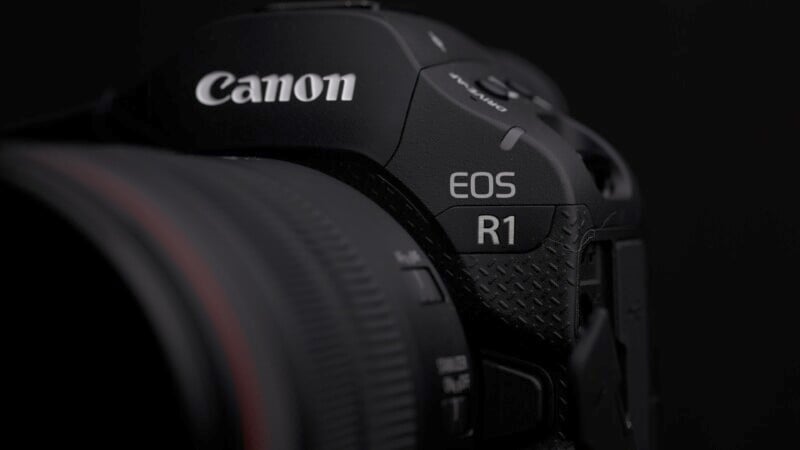 The EOS R1 is the long-anticipated camera at the top of the Canon tier.
The EOS R1 is the long-anticipated camera at the top of the Canon tier. The body design is comfortable and customizable. The grip feels natural and the overall weight is even on the lighter side.
The body design is comfortable and customizable. The grip feels natural and the overall weight is even on the lighter side.Canon has always impressed me with its simple menu design and intuitive controls. A flagship camera has to offer tons of customization and multiple pathways to change controls and settings. The R1 is an advanced camera with all the customization you would need but it never felt difficult to manipulate or convoluted to manage. I happily ignore features like the Smart Controller with its optically based detection of your thumb or its new half-press functionality and rather use it as a glorified AF ON button instead. This is the level of customization that you can have as you decide to make things as simple or complicated as you wish.
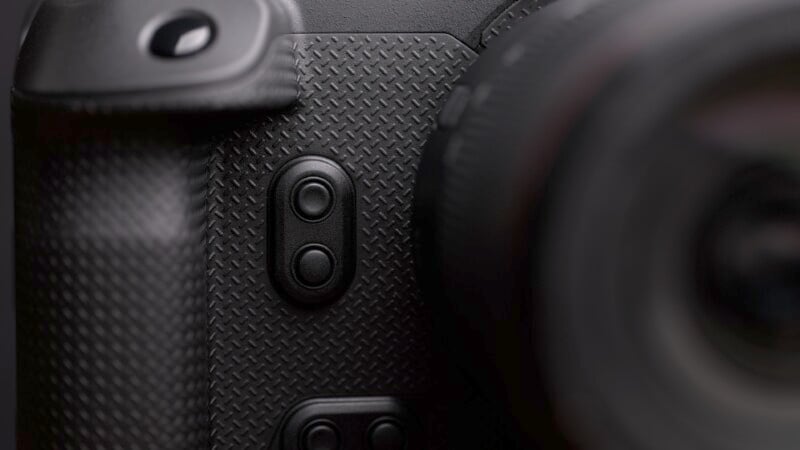 If you want customizability the R1 has all you need, and more.
If you want customizability the R1 has all you need, and more.There is a classic AF joystick as well and all the buttons feel natural in their respective positions on the body. The grip is a “Goldilocks” situation for sure and I like the feel of the new texture too, although it does remind me of a galvanized steel plate that belongs on the side panels of a Jeep more than a camera. Regardless, I feel the Canon EOS R1 is a well-designed body that strikes a harmonious balance between size and capability while also giving users an intuitive experience getting to grips with its full capabilities.
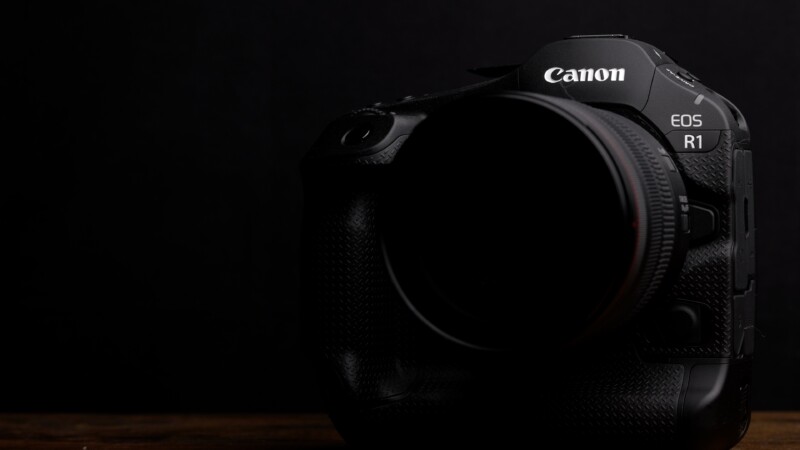 The R1 is a very capable camera but it relies on the smaller R5 MKII to handle higher megapixel photography.
The R1 is a very capable camera but it relies on the smaller R5 MKII to handle higher megapixel photography.The back LCD panel is fully articulated although it does take a big resolution hit down to 2.1-million dots compared to the R3 panel. It’s an acceptable trade-off to get the brilliant 9.44-million dot EVF that the R1 has with enhanced brightness and zero blackouts while shooting bursts. The refresh rate is excellent for sports and action and there was no drop in resolution when the camera was focusing or shooting.
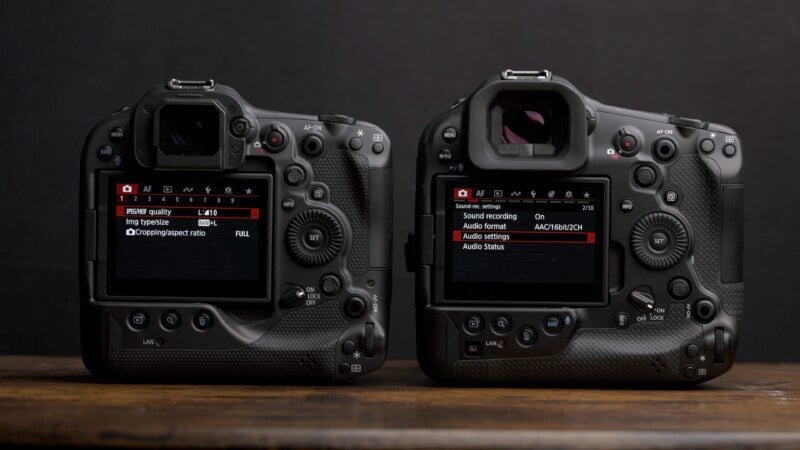 The R1 and R3 have a very similar look and feel to each other. Curiously, both cameras seem to be aimed at the same market.
The R1 and R3 have a very similar look and feel to each other. Curiously, both cameras seem to be aimed at the same market.This new EVF’s optical scanners have a wider field of view that tracks your eye movement when using Canon’s proprietary Eye Control AF. Unfortunately, I found the opposite to be true, in so far as the accuracy and consistency of the Eye Control AF calibration seem way more fiddly and problematic than when I calibrated the R3 to my eyes. I can make it work, but not without multiple failures and experimentation first.
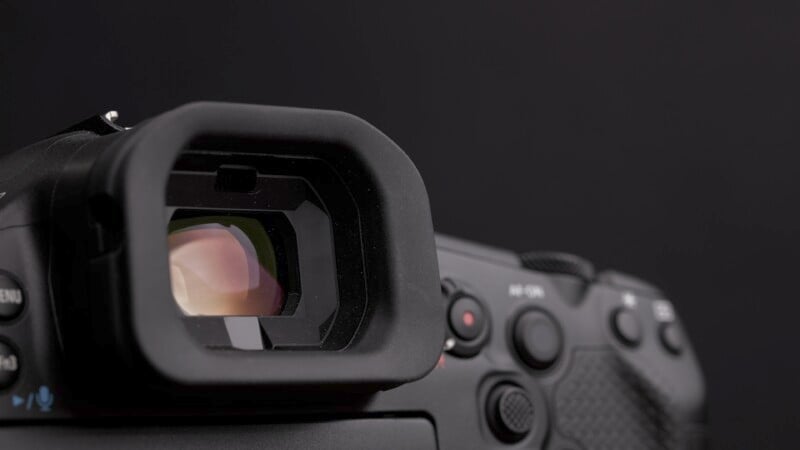 The EVF is large and bright with excellent overall detail. I did struggle to get the autofocus to calibrate though.
The EVF is large and bright with excellent overall detail. I did struggle to get the autofocus to calibrate though.For a camera that is so intuitive to control, this aspect of the R1 is disappointing, to say the least. Of course, the successful calibration of Eye Control AF amongst the general populace has always been more akin to a lottery system based on what I can only assume has to do with karma or dumb luck. However, it worked almost flawlessly for me on the R3, making me into a big proponent of the technology and the R1 has now taken me a step back in that regard.
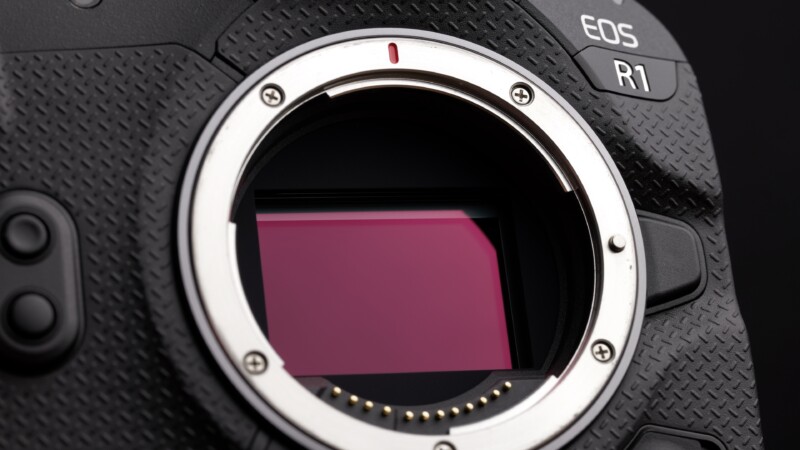 The R1 sensor is one of the fastest scanning chips we’ve tested.
The R1 sensor is one of the fastest scanning chips we’ve tested.The EOS R1 is the first camera I have seen that uses dual CFexpress Type B slots. This makes sense given the fast burst rates of the R1 and allows for dual recording on both cards at the same speed, unlike a single each of a CFexpress and SD arrangement. The classic LP-E19 battery makes a return but that’s just fine given the excellent all-day battery life that it provides.
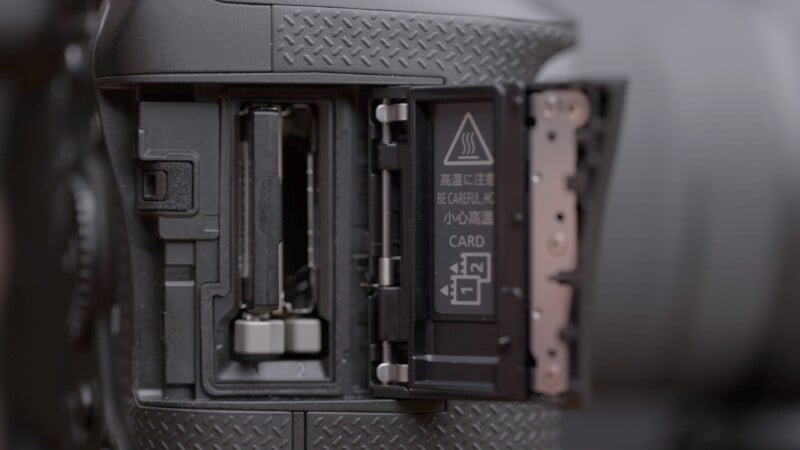 Dual CF Express Type B slots provide tons of fast storage and backups of important images.
Dual CF Express Type B slots provide tons of fast storage and backups of important images.Canon EOS R1 Review: How it Shoots
It becomes obvious very quickly that the R1 is a specialized sports and action camera. The burst rates can reach up to 40 frames per second (FPS) while still shooting RAW. There is a minor compromise as it must be done in Canon’s compressed RAW format but the quality is still excellent and the speeds are faster than the Nikon Z8 and Z9. The buffer is also remarkably large with the ability to shoot for over 10 seconds at 40 FPS in RAW before the camera slows. The twin CF Express cards clear out said buffer in a hurry, too.
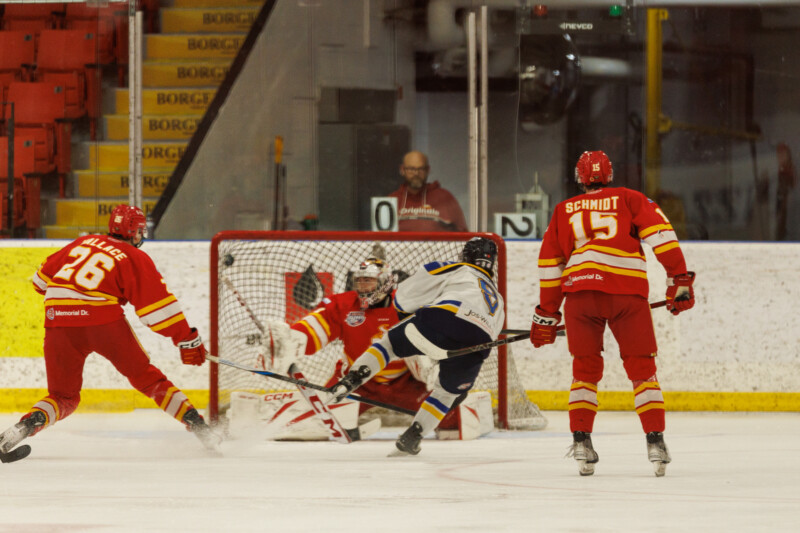 The action was pretty intense during this particular game with lots of goals scored.
The action was pretty intense during this particular game with lots of goals scored. The fast burst rates and long buffer meant that I could confidently get the moment that the puck goes in and take my pick from multiple shots.
The fast burst rates and long buffer meant that I could confidently get the moment that the puck goes in and take my pick from multiple shots.Canon decided to go with a fairly conservative 24-megapixel sensor which is ideal for journalism but maybe not so much for studio and landscape. That said, it is a very advanced stacked CMOS sensor that has one of the fastest read-out speeds we’ve seen to date. The electronic shutter scans at around 1/350 of a second which gives a flash sync speed of 1/320 and virtually eliminates rolling shutter issues. The mechanical shutter can manage burst rates up to 12 FPS which is respectable but with a slower flash sync speed of 1/200, we wonder why Canon even kept the shutter in the camera in the first place.
 The level of detail is ideal for sports and journalism photos. Low-light quality is good even at high ISO ranges.
The level of detail is ideal for sports and journalism photos. Low-light quality is good even at high ISO ranges.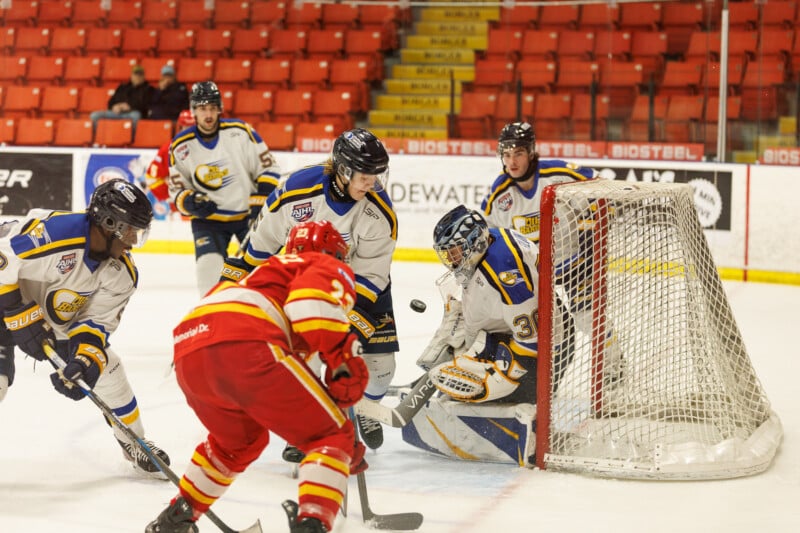 40 fps bursts are certainly handy to have but I found that 20 fps was plenty for most situations and saved space on my cards.
40 fps bursts are certainly handy to have but I found that 20 fps was plenty for most situations and saved space on my cards.Most cameras also have reduced dynamic range when using the electronic shutter but the R1 delivers similar results regardless of if you pick mechanical or electronic. As per usual, Canon bakes a little bit of noise reduction into the files, even the RAWs. Image quality is still excellent of course, with beautiful colors and rich detail, but it’s still worth pointing out.
I do personally prefer a higher megapixel count for general photography although I see why Canon would consider 24 megapixels ideal for faster shooting and journalistic photography. It is one more reason why the R1 is a particularly specialized tool.
 The eye detection of the AF systems is effective even at far distances.
The eye detection of the AF systems is effective even at far distances.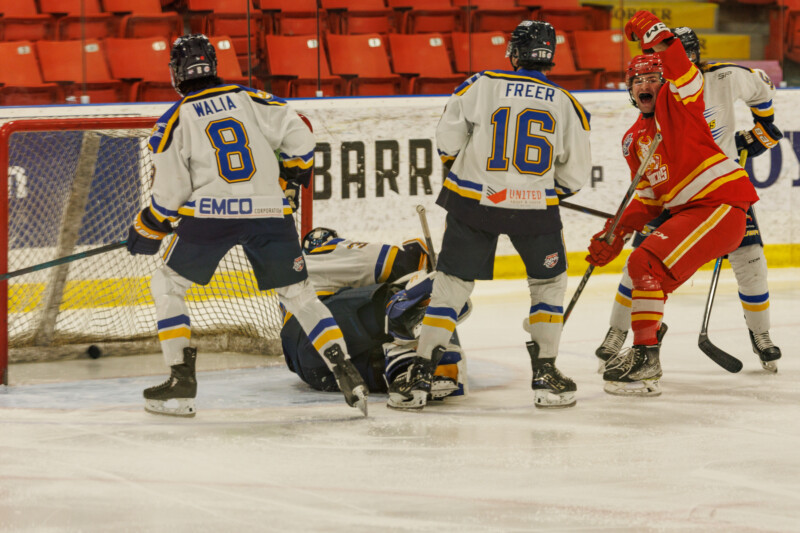 I never felt like I missed the action with the R1 and the focus was always reliable.
I never felt like I missed the action with the R1 and the focus was always reliable.As I stated earlier, we wanted to test the R1 in a situation that it isn’t trained for. As a recap, one of the new features in the R1 is what Canon calls the Action Priority function, which is tuned for specific sports and predicts where the focus should go for basketball, soccer, and volleyball.
It works incredibly well giving a helps to provide a very high hit rate. But what about a sport that it isn’t programmed for? Hockey provides a lot of fast action, in fairly low light, with lots of players on the ice, and all are wearing faceguards and helmets which obscures much of what Canon’s camera would be looking to identify.
 The autofocusing did a brilliant job of tracking players across the ice.
The autofocusing did a brilliant job of tracking players across the ice.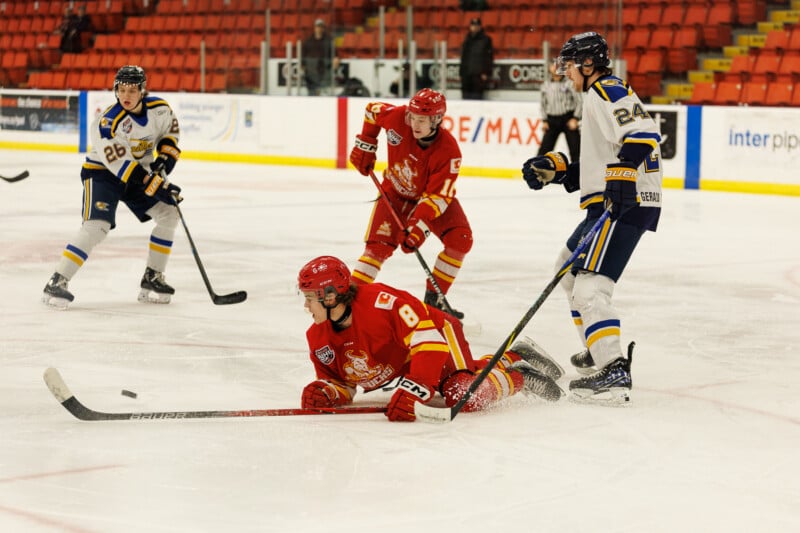 Eye Control AF worked well for situations where my eye naturally went to the action.
Eye Control AF worked well for situations where my eye naturally went to the action.I was very impressed with how it remained on players that I had initially started tracking and ignored subjects that came in between me and my target, all through thick glass around the rink as well. Canon has also simplified the focusing menu from previous cameras which, rather than taking control away, is easy to understand and effective in the field.
The R1 uses a sophisticated algorithm that can go from eyes to faces, to torsos, and my resulting hit rate was very high. This is no doubt improved with the sensor reading out so quickly and providing lots of data and calculations for the camera to focus on.
I would say the EOS R1 is the best focusing camera in Canon’s lineup and although the R3 and R5 Mark II can come close, there is an appreciable difference. This incredible hit rate is even more effective when the sport is supported by the Action Priority function so I hope to see more sports added in future updates.
 I used the pre-burst function a lot. I could watch a scene unfold and then commit to the sequence if desired after the action took place.
I used the pre-burst function a lot. I could watch a scene unfold and then commit to the sequence if desired after the action took place. I felt confident that I could get the shot with the R1. It is a hell of a good sports camera.
I felt confident that I could get the shot with the R1. It is a hell of a good sports camera.Canon has thrown in all the technology it has to bear in this camera including the latest IBIS technology and a pre-capture mode that retains the first 20 images before the shutter is pressed. I found myself using the pre-capture mode religiously for hockey not only to ensure the key movement was captured but also to minimize how many thousands of images I would have to wade through later.
Canon does make a big deal about its new “AI” based in-camera editing features, although their usefulness feels somewhat fringe. The first is an up-res feature that works on JPEGs and provides a big megapixel boost. In practice, I find this feature pretty superfluous because although the megapixels grow, perceived detail does not. I would only use it as a quick aside if a certain megapixel threshold was needed by an editor or printer.
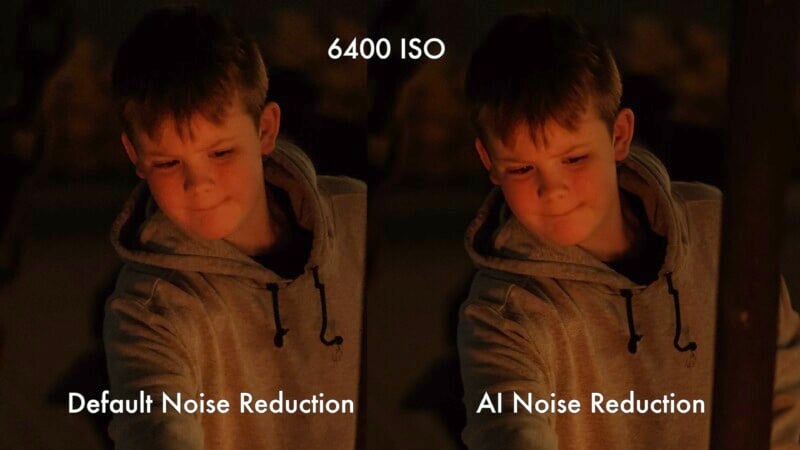 The built-in noise-reduction and up-res features are okay in a pinch but I would rather manipulate the photos on a computer.
The built-in noise-reduction and up-res features are okay in a pinch but I would rather manipulate the photos on a computer.There is also an in-camera noise reduction feature that works on RAW files (to produce a JPEG) and it can be helpful in some situations. The look of the noise reduction is dramatic and detail loss is minimal. I could see a sports photographer in a rush using this feature occasionally, although in the end both up-res and noise reduction features can be done more effectively on the computer afterward.
Canon EOS R1 Review: Much Improved Video
At first glance, the R1 seems to deliver very similar video capabilities to the R3. However, it turns out that the R1 is a far more functional video platform than the R3 that came before it. 6K recording is possible up to an impressive 60 FPS using Canon’s internal recording C-RAW Light mode. The quality is decent and it is an efficient recording codec but 6K video can only be shot in a raw mode.
In a more common standard 10-bit 4K recording mode, the R1 can push up to 120FPS at an albeit sub-sampled quality level. 60FPS is oversampled, however, and quite good. CLog 2 is also present and provides a good amount of dynamic range to work with — it is our preferred Canon log profile. The R1 also comes equipped with a tally lamp which is always appreciated by presenters and the R1 gets rid of the silly micro HDMI port on the R3 and exchanges it for a proper full-size port.
Although the autofocus did sometimes drift when many players were in frame during our hokey game testing, the Canon R1 seems to be far more reliable than the R3 when it comes to following the action in video mode overall.
The Canon EOS R1 is the Perfect Camera for a Very Particular Photographer
You could argue that all flagship cameras are a niche product for a certain echelon of professional photographers– and you would be correct. However, some cameras like the Nikon Z9 and Sony Alpha 1 can handle many kinds of photography while still giving the ultimate in ruggedness and customization. Perhaps the Canon R1 is too specialized for its own good and many of the people we spoke to who tested the R1 found the R5 Mark II to be the more useful choice given its greater versatility. The R1 seems to be covering territory already trodden by the EOS R3.
That being said, the R1 is incredible at what it does. It shoots faster than almost every camera except the Sony a9 III, is rugged and reliable, and can shoot non-stop for a long time. The autofocus is reliable and good at tracking many different subjects. Canon makes excellent sports glass too, which the R1 takes full advantage of.
The R1 is ideal as a sports and journalism camera and could find some use as a wildlife camera, too. If you are interested in this kind of photography and if it makes sense to pay $6,300 to get it, the R1 could be the perfect tool for you.
Are There Alternatives?
The Canon EOS R3 can deliver similar results and also has an excellently designed body. It may not quite have the same EVF but it’s a fast shooting platform with excellent autofocus. The presence of the R1 should push the price down as well.
Outside of Canon, Sony’s a9 III and Nikon’s Z9 are the most obvious direct competitors. The a9 III’s global shutter means it is capable of everything the EOS R1 is and more, but it does take a stronger hit to dynamic range than Canon’s new flagship in exchange. The Z9 isn’t as fast as the R1 but it does bring much higher resolution into play. The same could be said of Sony’s Alpha 1.
Should You Buy It?
Maybe. If you are into a demanding and selective kind of photography the EOS R1 is ideal. Otherwise, the EOS R5 MarK II might be the better purchase.

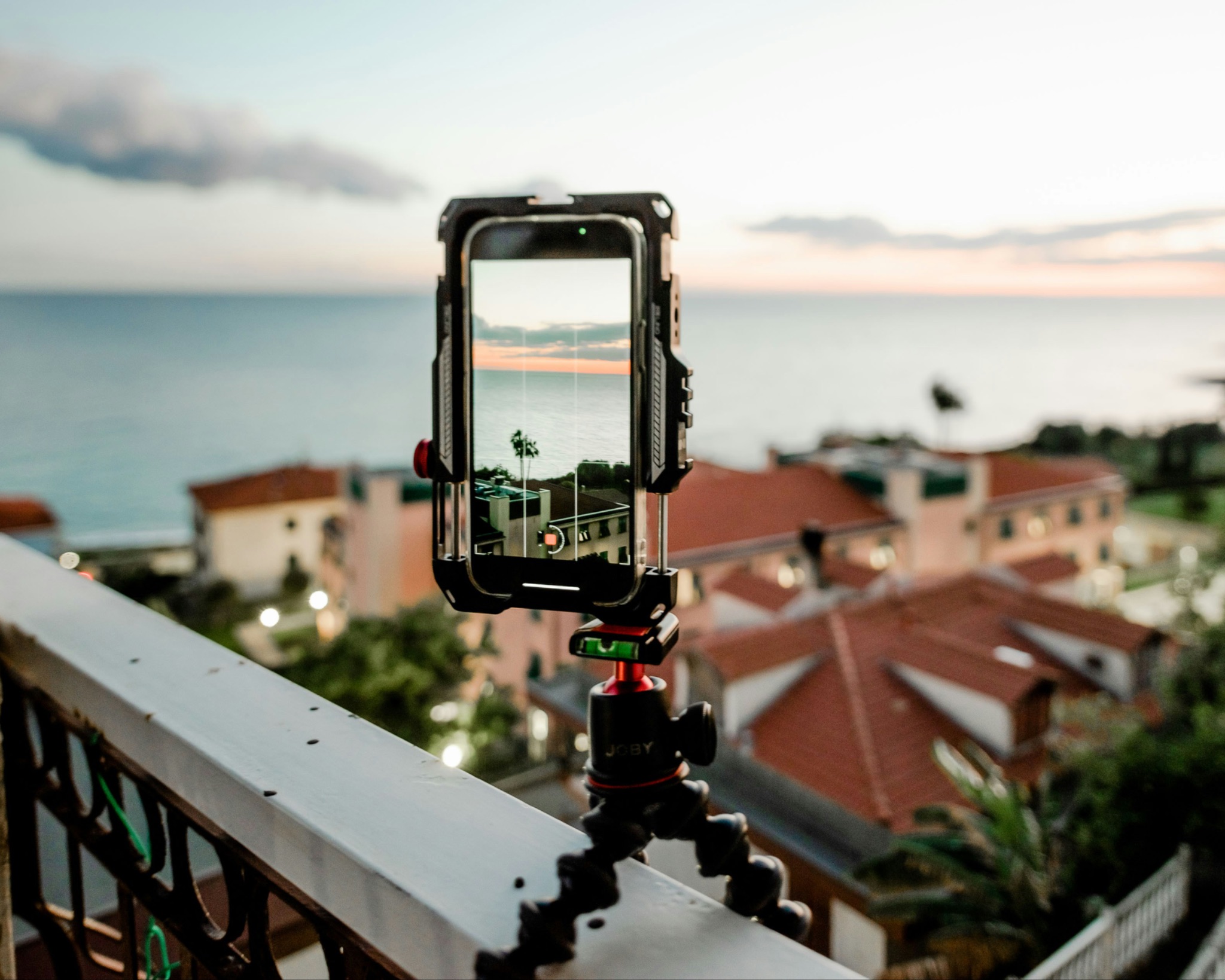


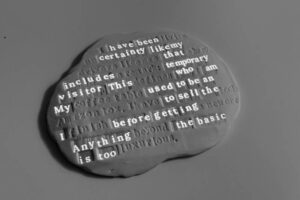
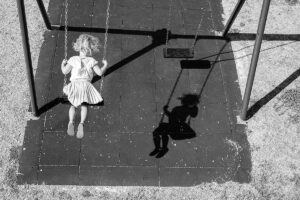



 English (US) ·
English (US) ·